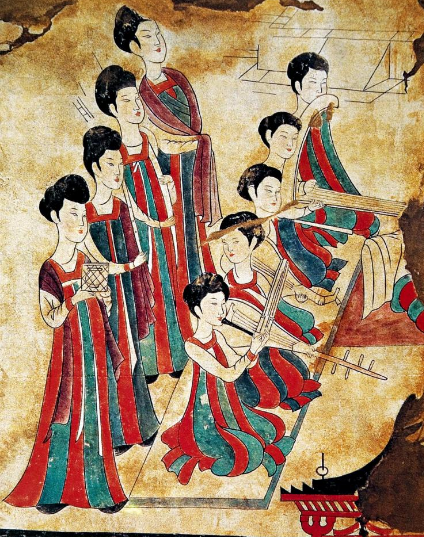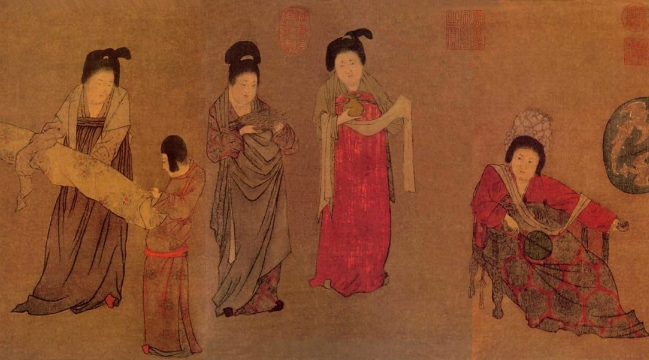The Ruqun style originated in early Chinese dynasties, reflecting cultural and social norms.
Ancient Origins of Ruqun
Ruqun in Early Chinese Dynasties
Ruqun, a traditional Chinese attire, first emerged during the Shang and Zhou dynasties, thriving between 1600 BC and 256 BC. This period saw the initial unification of attire styles across the vast Chinese empire, with Ruqun becoming prominent. It consisted of a blouse (ru) and a skirt (qun), symbolizing the elegance and simplicity of ancient Chinese fashion. Notably, during the Zhou Dynasty, Ruqun became a standard for women, reflecting social hierarchies and norms. The attire varied in color and fabric, often indicating the wearer’s social status. Silk, a luxurious material, was predominantly used by the upper class, while commoners opted for hemp or cotton.

The Cultural and Social Role of Ruqun
Beyond mere clothing, Ruqun played a significant role in ancient Chinese culture. It was an embodiment of Confucian ideals, emphasizing modesty and propriety. The design and length of the Ruqun were crafted to adhere to societal norms, with longer lengths and higher collars for increased modesty. In literature and art, Ruqun frequently appeared as a symbol of traditional femininity and grace. In famous works like “Dream of the Red Chamber,” one of China’s Four Great Classical Novels, characters often wore Ruqun, showcasing its deep cultural significance. During important festivals or ceremonies, Ruqun was the preferred attire, adding a sense of formality and respect to the events.
This attire also evolved to reflect regional differences. In the northern parts of China, where the climate was colder, Ruqun featured thicker fabrics and additional layers for warmth. In contrast, the southern versions were lighter and more breathable, suitable for the humid and hot weather. This adaptability highlights the Ruqun’s functionality and its integration into daily life across various regions in China.
The Ruqun style remains a fascinating subject of study for historians and fashion researchers, providing insights into ancient Chinese society and its values. Its elegance, historical significance, and cultural impact continue to captivate people around the world, with Wikipedia providing a wealth of information on this traditional attire.
Development and Evolution of Ruqun
Influences from Historical Events
The development of Ruqun has been significantly shaped by major historical events. During the Han Dynasty (206 BC – 220 AD), when the Silk Road opened, Ruqun experienced an infusion of foreign influences. Silk became more accessible, leading to finer and more diverse Ruqun styles. This era marked the introduction of intricate embroideries and varied colors in Ruqun, reflecting the growing prosperity of China.
The Tang Dynasty (618-907 AD) brought another pivotal change. With the empire’s expansion and increased cultural exchanges, Ruqun evolved to be more elaborate and colorful. The Tang era Ruqun often featured wide sleeves and a high waist, mirroring the era’s artistic and cultural opulence. This period also saw increased gender fluidity in clothing, with women adopting styles traditionally worn by men, further diversifying the Ruqun style.
During times of turmoil, like the Mongol invasion and the subsequent Yuan Dynasty (1271-1368 AD), Ruqun designs reflected the cultural blend between Chinese and Mongolian styles. The simplicity of Ruqun during this period was a testament to the socio-political changes and the practical needs of the time.
Ruqun’s Adaptations Over Time
As centuries passed, Ruqun continued to adapt, reflecting the evolving societal norms and technological advancements. The Ming (1368-1644 AD) and Qing (1644-1912 AD) dynasties saw the return of more traditional, conservative styles. The Qing era, in particular, emphasized strict Confucian codes of conduct, which were mirrored in the modest designs of Ruqun.
In modern times, while traditional Ruqun is less commonly worn in daily life, it has seen a resurgence as a symbol of cultural heritage. Contemporary designers often blend traditional Ruqun elements with modern fashion trends, creating outfits that honor historical designs while catering to modern aesthetics. This fusion symbolizes the dynamic nature of Chinese culture and its ability to adapt and evolve while retaining its core identity.
For more detailed information on the evolution and various styles of Ruqun, resources like Wikipedia offer comprehensive overviews. These adaptations of Ruqun over time reflect not just changes in fashion but also the broader historical and cultural shifts within Chinese society.
Regional Variations of Ruqun
Northern and Southern Styles in Ancient China
In ancient China, the Ruqun style varied significantly between the northern and southern regions, primarily due to climatic differences. In the north, where the climate is colder, people wore Ruqun made of thicker fabrics like wool and heavy silk. These garments often featured additional layers for insulation, and the colors tended to be darker and more subdued.
In contrast, the southern regions of China, known for their warmer and more humid climate, favored Ruqun made from lighter materials like fine silk and linen. The designs in the south were more vibrant and featured lighter colors, reflecting the liveliness of the region. The skirts in southern Ruqun were often wider and airier, providing comfort in the hot climate.
This variation in style not only showcases the adaptability of traditional Chinese clothing to different environments but also illustrates the diversity within Chinese culture itself. The regional styles of Ruqun became a marker of identity, with distinct characteristics that were easily recognizable.
Influence of Geographic and Climatic Factors
Geography and climate played crucial roles in shaping the Ruqun styles across different regions of China. In mountainous areas, for instance, the Ruqun was more robust and practical, designed to withstand the harsher conditions. In contrast, in the fertile river valleys, where the climate was milder, Ruqun styles were more elaborate, often used to display wealth and status.
The choice of fabric, color, and design in different regions was a direct response to the local climate and available resources. This regional diversity in Ruqun styles is a testament to the ingenuity and adaptability of ancient Chinese people, who skillfully tailored their clothing to suit their environment.
Below is a comparative table highlighting the differences between the Northern and Southern styles of Ruqun in ancient China:
| Aspect | Northern Style | Southern Style |
|---|---|---|
| Climate Adaptation | Thicker fabrics for cold weather | Lighter materials for warmth and comfort |
| Material | Wool, heavy silk | Fine silk, linen |
| Color Palette | Darker, more subdued tones | Vibrant, lighter colors |
| Skirt Design | Less voluminous | Wider and airier |
| Regional Identity | Practical and robust | Elaborate and luxurious |
For more detailed information on the regional variations of Ruqun, Wikipedia offers a comprehensive overview. These variations are not just a matter of fashion but reflect the rich tapestry of Chinese cultural and environmental diversity.

Ruqun in Historical Literature and Art
Depictions in Classical Chinese Literature
Ruqun has a prominent presence in classical Chinese literature, often serving as a symbol of elegance and cultural tradition. In the masterpiece “Dream of the Red Chamber,” one of China’s Four Great Classical Novels, characters frequently don Ruqun, depicting the lifestyle of the aristocratic families of the Qing Dynasty. The detailed descriptions of Ruqun in this novel reflect its importance in social status and personal identity.
Poetry from the Tang and Song dynasties also frequently mentions Ruqun, using it to convey the beauty and grace of women in that era. Poets like Li Bai and Du Fu have incorporated vivid imagery of Ruqun in their works, making it a significant element in the portrayal of feminine beauty and elegance.
Ruqun in Traditional Chinese Art
In traditional Chinese art, Ruqun takes center stage in many paintings and sculptures, highlighting its cultural significance. The famous Tang Dynasty mural paintings in the Dunhuang caves showcase elegant figures adorned in Ruqun, revealing the fashion and social customs of the time. These artworks provide valuable insights into the design and style of Ruqun, as well as the social dynamics of the period.
Similarly, during the Ming and Qing dynasties, Ruqun appeared in numerous scroll paintings, often as a part of scenes depicting daily life or historical events. These artistic representations serve as historical records, offering a glimpse into the past and the evolution of Chinese clothing styles.
For more information on Ruqun’s role in literature and art, resources like Wikipedia offer a comprehensive historical context. These artistic and literary depictions not only highlight the aesthetic appeal of Ruqun but also underscore its deep-rooted significance in Chinese culture and history.